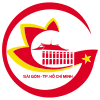Ho Chi Minh City
Thành phố Hồ Chí Minh Saigon (Sài Gòn) | |
|---|---|
| Nicknames: | |
| Motto(s): | |
 Interactive map outlining Ho Chi Minh City | |
 | |
| Coordinates: 10°46′32″N 106°42′07″E / 10.77556°N 106.70194°E | |
| Country | Vietnam |
| Region | Southeast |
| Founded | 1698 |
| Change of name | 1976 |
| Founded by | Nguyễn Hữu Cảnh |
| Named for | Ho Chi Minh |
| Districts | 16 urban districts, 5 rural districts and 1 sub-city |
| Government | |
| • Type | Municipality |
| • Body | Ho Chi Minh City People's Council |
| • Secretary of CPV | Nguyễn Văn Nên |
| • Chairwoman of People's Council | Nguyễn Thị Lệ |
| • Chairman of People's Committee | Phan Văn Mãi |
| Area | |
| 2,095.39 km2 (809.03 sq mi) | |
| • Metro | 30,595 km2 (11,813 sq mi) |
| Elevation | 19 m (63 ft) |
| Population | |
| 9,456,700 | |
| • Rank | 1st |
| • Density | 4,513/km2 (11,690/sq mi) |
| • Urban [4]: 113 | 7,344,000 |
| • Rural [4]: 115 | 2,112,700 |
| • Metro | 22,552,900 (1st) |
| • Metro density | 737/km2 (1,910/sq mi) |
| Demonym | Saigonese |
| GRDP (Nominal) | |
| • Municipality (Special) | US$ 68.1 billion (2023)[5] |
| • Metro | US$ 133.1 billion (2023) |
| Time zone | UTC+7 (Indochina Time) |
| Postal code | 70xxx–74xxx |
| Area codes | 28 |
| ISO 3166 code | VN-SG |
| License plate | 41, 50–59 |
| HDI (2022) | (3rd) |
| International airports | Tan Son Nhat International Airport (SGN) |
| Rapid transit system | Ho Chi Minh City Metro |
| Website | hochiminhcity |
Ho Chi Minh City (HCMC; Vietnamese: Thành phố Hồ Chí Minh), better known as Saigon (Vietnamese: Sài Gòn), is the most populous city in Vietnam, with a population of around 10 million in 2023.[7] The city's geography is defined by rivers and canals, of which the largest is Saigon River. As a municipality, Ho Chi Minh City consists of 16 urban districts, five rural districts, and one municipal city (sub-city). As the largest financial centre in Vietnam, Ho Chi Minh City has the highest gross regional domestic product out of all Vietnam provinces and municipalities,[8] contributing around a quarter of the country's total GDP.[9] Ho Chi Minh City's metropolitan area is ASEAN's 6th largest economy, also the biggest outside an ASEAN country capital.
Since ancient times, water transport has been heavily used by inhabitants in the area. The area was occupied by Champa from 2nd century AD to around the 19th century, due to Đại Việt's expansionist policy of Nam tiến. After the fall of the Citadel of Saigon, the city became the capital of French Indochina from 1887 to 1902, and again from 1945 until its cessation in 1954. Following the partition of French Indochina, it became the capital of South Vietnam until it was captured by North Vietnam, who renamed the city after their former leader Hồ Chí Minh, though the former name is still widely used in informal usages. Beginning in the 1990s, the city underwent rapid expansion and modernization, which contributed to Vietnam's post-war economic recovery and helped revive its international trade hub status.
Ho Chi Minh City has a long tradition of being one of the centers of economy, entertainment and education in Vietnam. As such, the city is also the busiest international transport hub in Vietnam, as Tân Sơn Nhất International Airport accounts for nearly half of all international arrivals to Vietnam[10] and the Port of Saigon is among the busiest container ports in Southeast Asia.[11] Ho Chi Minh City is also a tourist attraction. Some of the war and historic landmarks in the city include the Independence Palace, Landmark 81 (tallest building in Vietnam), the War Remnants Museum, and Bến Thành Market. The city is also known for its narrow walkable alleys and bustling night life. Currently, Ho Chi Minh City is facing increasing threats of sea level rise and flooding as well as heavy strains on public infrastructures.
- ^ "Saigon, Paris of the Orient, shows war tarnish". Lodi News-Sentinel. 7 April 1971. Archived from the original on 8 December 2015.O
- ^ Cherry, Haydon (2019). Down and Out in Saigon: Stories of the Poor in a Colonial City. Yale University Press. p. 29. ISBN 978-0-300-21825-1.
- ^ Biểu số 4.5: Hiện trạng sử dụng đất vùng Đông Nam Bộ năm 2022 [Table 4.5: Current land use status in the Southeast region in 2022] (PDF) (Decision 3048/QĐ-BTNMT) (in Vietnamese). Ministry of Natural Resources and Environment (Vietnam). 18 October 2023. – the data in the report are in hectares, rounded to integers
- ^ a b c Statistical Yearbook of Viet Nam 2023 (PDF) (in Vietnamese and English). Vietnam: Statistical Publishing House. 29 June 2024. ISBN 978-604-75-2429-7.
- ^ "Statistics". Ho Chi Minh City Statistics Office.
- ^ "Human Development Index by province(*) by Cities, provincies and Year". General Statistics Office of Vietnam. Retrieved 28 September 2024.
- ^ Cite error: The named reference
2019censuswas invoked but never defined (see the help page). - ^ "Đóng góp của các tỉnh, thành phố về một số chỉ tiêu chủ yếu". kinhtetrunguong.vn (in Vietnamese). 20 March 2023. Retrieved 7 January 2024.
- ^ Onishi, Tomoya. "Vietnam to boost Ho Chi Minh budget for first time in 18 years". Nikkei Asia. Retrieved 30 August 2022. (Subscription required.)
- ^ "Military land approved for new Tan Son Nhat airport terminal". VnExpress. Retrieved 30 August 2022.
- ^ "Three Vietnamese seaports among top 100 largest container ports worldwide". General Statistics Office of Vietnam. Retrieved 27 December 2023.









